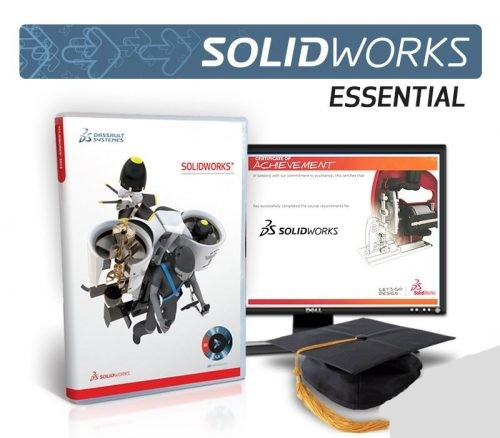
SOLIDWORKS—as you might already know—is a solid modeling CAD and CAE program. Owned by Dassault Systems, SOLIDWORKS is used by millions of engineers and designers worldwide. With so many capabilities, it’s no surprise to find that it competes with the best in the CAD industry—allowing users to push the boundaries with design and engineering. You might already think of yourself as an expert in SOLIDWORKS, but do you know about SOLIDWORKS history?
Scan2CAD is here to educate users on SOLIDWORKS turbulent and interesting history. So, if you want to know about its origins, version history, and its many uses, simply read on.
SOLIDWORKS was founded in December 1993 by Jon Hirschtick who used the $1 million he made while a member of the MIT Blackjack Team to set up the company. Hirschtick then recruited a team of engineers who set out with the aim of creating 3D CAD software. It was intended to be accessible, affordable and available on Windows desktop.
Soon after, in November 1995, SOLIDWORKS was released. It was the first significant modeler for Windows. This proved to be a huge step in the subsequent evolution of CAD. While AutoCAD had been released much earlier, SOLIDWORKS brought something new to the table—3D modeling. Consequently, 3D CAD became the focal point of the 1990s. Within months, SOLIDWORKS changed the way engineers brought their creations to life.
SOLIDWORKS was so impressive in fact, that by 1997 it was acquired by none other than Dassault Systems—best known for CATIA—for a staggering $320 million in stock. Jon Hirschtick stayed on board for the next 14 years. Under his leadership, SOLIDWORKS grew to a $100 million revenue company. Hirschtick later left to found another familiar company, On shape, offering cloud-based CAD.
Final year students of engineering and professional courses are worried about their industrial training, project work, and placement. Some good industry training institutes come up with industry-ready courses focusing on the latest market trends. The training program starts with the fundamental concepts, and hands-on experience, moving towards the development of real-time projects under the mentorship of certified trainers and experienced professionals.
Major areas of employment for mechanical engineers are manufacturing and designing. When the need of improved design or new product arises, the engineers with innovative designing skills are called. To meet the employment criteria, synching the industrial training project with the job requirements is a good idea.
| SOLIDWORKS Syllabus | Total Duration : 60 Hour |
|---|---|
| Session 1 | Introduction to CAD, Features of SOLIDWORKS, Various products available in SOLIDWORKS for Product Design, Simulation, Communication SOLIDWORKS Graphical User Interface – Feature manager design tree, Callouts, Handles, Confirmation corner, mouse buttons, keyboard shortcuts, Command Manager, Hardware and Software requirements, SOLIDWORKS Task Scheduler, SOLIDWORKS Rx. |
| Session 2 |
SKETCHERSketch Entities – Inference line, Centerline line, Line, Circle, Arc, Ellipse, Rectangle, Slots, Polygon, Parabola, Ellipse, Partial Ellipse, Spline, Spline tools, Spline on surface, Equation driven curve, Points, Text, Construction geometry, Snap, grid. |
| Session 3 | Sketch Tools – Fillet, Chamfer, Offset, Convert entities, Intersection curve, Face curve, Trim, Extend, Split, Jog Line, Construction Geometry, Mirror, Dynamic Mirror, Move, Copy, Rotate, Scale, Stretch, Sketch pattern , Polygon ,Make path, Close Sketch To Model, Sketch picture, Check Sketch for Feature, Area hatch/Fill. Relations – Adding Sketch Relation, Automatic relations, Dimensioning – Smart, Horizontal, Vertical, Ordinate, Horizontal ordinate, Vertical ordinate, Align ordinate, Fully define sketch. Sketch Diagnosis, SketchXpert, 3D Sketching, Rapid Sketch. |
| Session 4 |
PART MODELINGPart Modeling Tools Creating reference planes Creating Extrude features – Direction1, Direction2, From option, Thin feature, Applying draft, Selecting contours Creating Revolve features – Selecting Axis, Thin features, Selecting contours Creating Swept features-Selecting, Profile and Path,Orientation/twist type, Path Alignment, Guide Curves, Start/End tangency, Thin feature. Symmetry and Draft- Selecting the symmetry and to be able to do draft analysis |
| Session 5 | Creating Loft features – Selecting Profiles, Guide curves, Start/End Constraints, Centerline parameters, Sketch tools, Close loft. Selecting geometries – Selection Manager, Multiple Body concepts. Creating Reference – points, axis, coordinates Inserting Hole types. Creating Pattern – Linear pattern, Circular pattern, Sketch driven pattern, Curve driven pattern, Table driven pattern, Fill pattern, mirror |
| Session 6 | Shelling and Ribs. |
| Session 7 | Creating Chamfer Repairs Creating Shell Creating Rib |
| Session 8 | Design Changes Inserting Fastening features- Mounting boss, snap hook, Snap hook groove, Vent |
| Session 9 | Environment & Utilities – Working with views and manipulating views, Trouble shooting Inserting Library feature, Adding Configuration, Inserting Design table, System options, Measuring Geometries, Calculating Mass Properties, Feature Statistics, Working With Equations |
| Session 10 | Configurations |
| Session 11 | Global Variables and Equations |
| Session 12 | Using Drawings |
| Session 13 |
BOTTOM-UP ASSEMBLY MODELINGAssembly Modeling Tools Introduction to Assembly Modeling & Approaches – Top down and Bottom up approach Applying Standard Mates- Coincident, Parallel, Perpendicular, Tangent, Concentric, Lock, Distance, Angle. Applying Advanced Mates – Symmetric, Width, Path Mate, Linear/Linear Coupler, Limit Mate. Applying Mechanical Mates – Cam, Hinge, Gear, Rack Pinion, Screw, Universal Joint. Applying Smart mates Applying Mate reference Creating Explode Views Top Down Design – Layout Sketch, Work Part In the Context of an assembly. |
4th Floor, Vijay Sai Towers, Plot No 410, 6-11 & 6-11/A, above Reliance Digital, opp. BJP Office Road, Hyderabad, Telangana 500072
Phone: +919505884798/ +919505884789
Email: helpdesk@customizecad.com
We are authorized SOLIDWORKS reseller in Hyderabad, Secunderabad and rest of all Telangana. Our Business development executives regularly visit Jeedimetla, Patancheru, Cherlapally, Balanagar, Hi-tech city, Madhapur and other industrial areas in and around Hyderabad.
Copyright 2021 P CAD CAM Customization | All Rights Reserved. Designed by Metromindz.